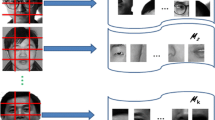Abstract
In this paper, multi-manifolds discriminative canonical correlation analysis (MMDCCA) is presented for solving face recognition problem with using different image sets. We adopt Linearity-Constrained Hierarchical Agglomerative Clustering algorithm for dividing all image sets into a range of local clusters. Then MMDCCA is proposed to find multiple orthogonal projection functions for maximizing the margins of manifolds with different persons. In order to obtain gains in discrimination accuracy, we enforce a constraint that each person-specific manifold is orthogonal to those of all other manifolds after linear transformation. An efficient sequential iterative learning algorithm is used for finding the discriminative features. Extensive experiments confirm the effectiveness of our model.




Similar content being viewed by others
Explore related subjects
Discover the latest articles, news and stories from top researchers in related subjects.References
Yasuomi D, Takao N, Keiichi H, Hiroyuki M. The Cognitive Mechanisms of Multi-scale perception for the recognition of extremely similar faces. Cognit Comput. 2015;7(5):501–8.
Wang R, Shan S, Chen X, Dai Q, Gao W. Manifold-manifold distance and its application to face recognition with image sets. IEEE Trans Image Process. 2012;21(10):4466–79.
Wang R, Chen X. Manifold discriminant analysis. In: Proceedings of the IEEE conference on computer vision pattern recognition; 2009. pp. 429–36.
Cevikalp H, Triggs B. Face recognition based on image sets. In: Proceedings of the IEEE conference on computer vision pattern recognition; 2010. pp. 2567–73.
Hu Y, Mian A, Owens R. Face recognition using sparse approximated nearest points between image sets. IEEE Trans Pattern Anal Mach Intell. 2012;34(10):1992–2004.
Fan W, Yeung D. Locally linear models on face appearance manifolds with application to dual-subspace based classification. In: Proceedings of the IEEE conference on computer vision pattern recognition; 2006. pp. 1384–90.
Wang T, Shi P. Kernel Grassmannian distances and discriminant analysis for face recognition from image sets. Pattern Recogn Lett. 2009;30(13):1161–5.
Jayasumana S, Hartley R, Salzmann M, Li H, Harandi M. Kernel methods on the Riemannian manifold of symmetric positive definite matrices. In: Proceedings of the IEEE conference on computer vision pattern recognition; 2013. pp. 73–80.
Fukui K, Yamaguchi O. Face recognition using multi-viewpoint patterns for robot vision. In: Proceedings of the international symposium of robotics research; 2003. pp. 192–201.
Todros K, Hero AO. On measure transformed canonical correlation analysis. IEEE Trans Image Process. 2012;60(9):4570–85.
Chu D, Liao LZ, Ng MK, et al. Sparse canonical correlation analysis: new formulation and algorithm. IEEE Trans Pattern Anal Mach Intell. 2013;35(12):3050–65.
Wolf L, Shashua A. Learning over sets using Kernel principal angles. J Mach Learn Res. 2003;4(10):913–31.
Fukui K, Stenger B, Yamaguchi O. A framework for 3D object recognition using the Kernel constrained mutual subspace method. In: Proceedings of Asian conference computer vision; 2006. pp. 315–24.
Fukui K, Yamaguchi O. The Kernel orthogonal mutual subspace method and its application to 3D object recognition. In: Proceedings of Asian conference computer vision; 2007. pp. 467–76.
Lu J, Tan Y, Wang G, Yang G. Image-to-set face recognition using locality repulsion projections and sparse reconstruction-based similarity measure. IEEE Trans Circuits and Syst Video Technol. 2013;23(6):1070–80.
Hu H. Sparse discriminative multi-manifold Grassmannian analysis for face recognition with image sets. IEEE Trans Circuits and Syst Video Technol. 2015;25(10):1599–611.
Kim T-K, Arandjelovic O, Cipolla R. Boosted manifold principal angles for image set-based recognition. Pattern Recogn. 2007;40(9):2475–84.
Lee K, Yang MH, Kriegman D. Video-based face recognition using probabilistic appearance manifolds. In: Proceedings of the IEEE conference on computer vision pattern recognition; 2003. pp. 313–20.
Gross R, Shi J. The CMU motion of body (MoBo) database. Robotics Institute, Carnegie Mellon Univ., Pittsburgh, PA, Tech. Rep. CMU-RI-TR-01-18; 2001.
Kim M, Kumar S, Pavlovic V, Rowley H. Face tracking and recognition with visual constraints in real-world videos. In: Proceedings of the IEEE conference on computer vision pattern recognition; 2008. pp. 1–8.
Viola P, Jones M. Robust real-time face detection. Int J Comput Vis. 2004;57(2):137–54.
Cevikalp H, Triggs B. Face recognition based on image sets. In: Proceedings of the IEEE conference on computer vision pattern recognition; 2010. pp. 2567–73.
Acknowledgments
This work was supported by the National Science Foundation of China (60802069 and 61273270), the Natural Science Foundation of Guangdong Province (2014A030313173), and Special Program for Applied Research on Super Computation of the NSFC-Guangdong Joint Fund (the second phase).
Author information
Authors and Affiliations
Corresponding author
Ethics declarations
Conflict of Interest
Haifeng Hu and Jianquan Gu declare that they have no conflict of interest.
Informed Consent
All procedures followed were in accordance with the ethical standards of the responsible committee on human experimentation (institutional and national) and with the Helsinki Declaration of 1975, as revised in 2008 (5). Additional informed consent was obtained from all patients for which identifying information is included in this article.
Human and Animal Rights
This article does not contain any studies with human participants or animals performed by any of the authors.
Rights and permissions
About this article
Cite this article
Hu, H., Gu, J. Multi-manifolds Discriminative Canonical Correlation Analysis for Image Set-Based Face Recognition. Cogn Comput 8, 900–909 (2016). https://doi.org/10.1007/s12559-016-9403-y
Received:
Accepted:
Published:
Issue Date:
DOI: https://doi.org/10.1007/s12559-016-9403-y




